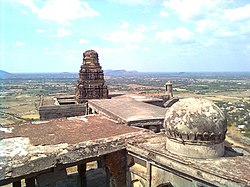Krishnagiri
Krishnagiri | |
|---|---|
city | |
 Remains of the ancient fort on the Syed Basha Hill | |
| Coordinates: 12°32′N 78°14′E / 12.53°N 78.23°ECoordinates: 12°32′N 78°14′E / 12.53°N 78.23°E ⧼validator-fatal-error⧽ | |
| Country | |
| State | Tamil Nadu |
| Region | Kongu Nadu |
| District | Krishnagiri |
| Named for | Ruled under Krishnadevarayar |
| Government | |
| • Type | Special Grade Municipality |
| • Body | Krishnagiri Municipality |
| • Member of Parliament (Lok Sabha) | A. Chellakumar |
| • Member of Legislative Assembly | T. Senguttuvan |
| Elevation | 492 m (1,614 ft) |
| Population (2011) | |
| • Total | 199,657 |
| Languages | |
| • Official | Tamil |
| Time zone | UTC+5:30 (IST) |
| PIN | 635001,635002,635115,635101,635120 |
| Telephone code | 4343 |
| Vehicle registration | TN 24 |
| Website | www |
Krishnagiri is a city in the state of Tamil Nadu, India, and it serves as the administrative headquarters of Krishnagiri District formed in 2004. It is located at the bottom of Syed Basha (people often call it as Karumalai) Hills, and the town is fully surrounded by hill rocks. It is located 90 kilometres (56 mi) from Bangalore, 45 km from Dharmapuri. Krishnagiri is known as "Mango Capital of India" as mangoes are cultivated as the main crop, and the land here is extremely fertile with rich access to fresh water making it amenable to growing crops. Krishnagiri is a rapidly growing town and is the site of significant business and residential development. The Krishnagiri Dam was built in 1967. Krishnagiri is currently undergoing expansion and a variety of small-scale industry zones are being set up. As of 2011, the town had a population of 199,657.
The Krishnagiri district has a prehistoric importance. Archeological sources confirm the presence of habitats of mankind during Paleolithic, Neolithic and Mesolithic Ages. Various rock paintings and rock carvings of Indus Valley civilization and Iron Age seen in this district support the historical significance of this district.
Krishnagiri region is a part of the ancient Kongu Nadu and Chera country. Historically it was ruled by Kongu and Chera rulers. Later the region came under Cholas, Pallavas, Gangas, Nulambas, Hoysalas, Vijaya Nagar and Bijapur emperors, Wodeyars of Mysore and Nayaks of Madurai. This region of Krishnagiri served as "Gateway of Tamil Nadu" and the protective barrier for the southern region defending onslaughts from invaders with motives of imperialism and exploitation. Krishnagiri Fort become the first and foremost defensive place. The majestic fortress, built on Krishnagiri hill by the Vijaya Nagar emperors, stands as testimony still now.
During Mysore war I, the British troops passed through Krishnagiri to attack Hyder Ali's Forces at Kaveripattinam. British army was defeated here. In Mysore war II after the "Treaty of Srirangapattinam" entire region of Salem and Barah Mahal were surrendered to the British. In 1792 AD, Captain Alexander Reed became the first District Collector of this region. Under the diplomacy of Robert Clive, the then Governor of Madras Presidency, Krishnagiri became the headquarters of Bara Mahal.
A mint was established at Krishnagiri in 1794 AD. Gold, silver and copper coins were forged here. Many soldiers from Krishnagiri region took part in the world war and lost their lives. Dr. C. Rajagopalachari hailed from a small village in this district rose to the highest position in the nation as the first Governor General of independent India, leader of the Congress Party, and as Chief Minister of Tamil Nadu. The historical importance and potential growth in education, economy and tourism of present Krishnagiri made it necessary to create a separate district. Krishnagiri was formed as 30th district by the Government of Tamil Nadu. Krishnagiri district was carved out of Dharmapuri district on 9 February 2004 with five taluks and ten blocks.[1]
- ↑ "Top at the Roll of Honour". Krishnagiri Collectorate. Krishnagiri, India. 9 February 2004.

